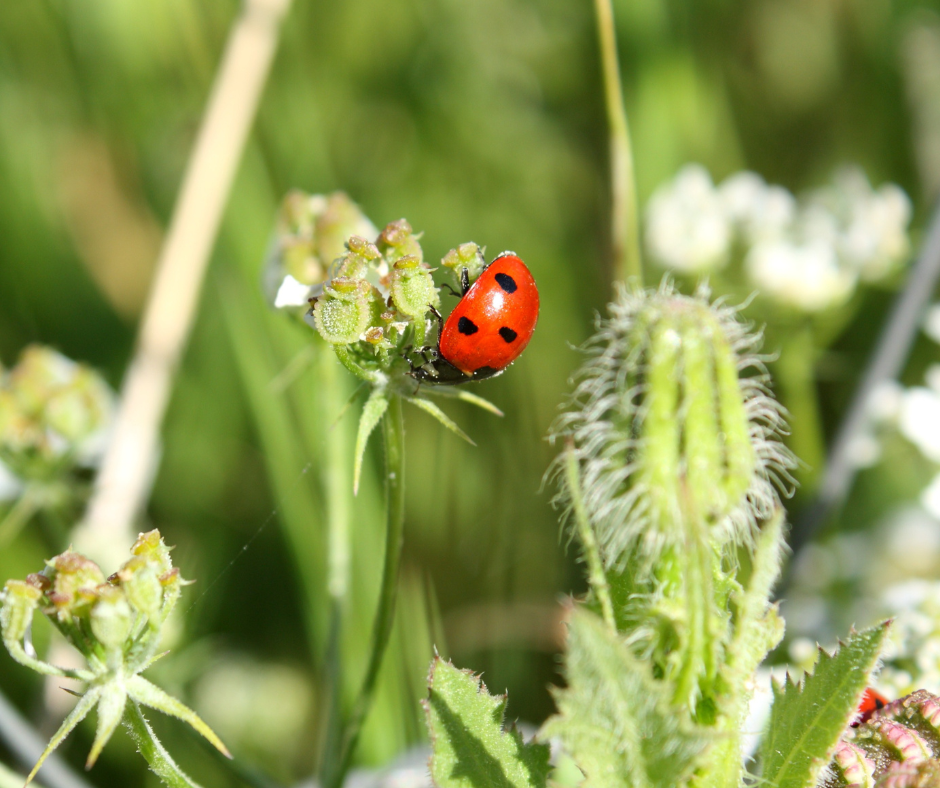Sometimes it feels like we spend a lot of time trying to keep bugs out of our garden, when actually it is useful to have some bugs around. Lots of bugs are beneficial for our gardens. Discover some local ones, how to attract them and keep them safe.

But first – who is helping and hurting your garden?
Some bugs can cause damage to our veggie gardens, like aphids that suck the nutrient-rich sap from our plants, cabbage moth larvae that munch through our leaves, snails and slugs that damage leaves and fruit, or mealybugs that takeover the foliage of plants.
While you might use plastic rings around your vegetable plants to keep the slaters away or crushed chilli to ward off the aphids, your best defence against these damaging pest insects might be to attract their natural predators… other bugs!
There are plenty of bugs that you do want around the garden, because they feed on these pests – and some of them can help pollinate our plants!
Take the humble ladybug – not only is this beetle beautiful to look at (and lucky if it lands on you, right?) but it can also eat about 50 aphids a day!
Lots of beetles feed on soft-bodied insects, along with their eggs and larvae – which means you want bugs like ground beetles, soldier beetles, and lots of other kinds of beetles around.
Plus lots of these are incidental pollinators, meaning these beetles move pollen about the garden as they go about their business.
Hoverflies, too, are great pollinators, and they munch through aphids in their larval stage.
And lacewings are good guys, as well. In their larval stage they eat aphids, some caterpillars, mealybugs and insect eggs.
Now that you know some of the beneficial bugs you want around – how do you attract them? Let’s discover 4 ways.

1. Plenty of pollen
Bringing good bugs into the garden requires plenty of pollen.
A lot of our good guy bugs feed on nectar and pollen in their adult stage, and then hang around to lay eggs, which hatch into the larvae. It’s the larvae than tend to do a lot of the pest control.
Choosing flowers with accessible pollen is the best way to guarantee success – this can be done by choosing compound flowers, or those where the flower head is made up of little flowers.
Lots of members of the daisy family fall into this category, and the native daisy-bush (Oleria) offers white flowers throughout spring. Other natives like kangaroo lobelia (Dampiera), native lilac (Hardenbergia violacea) and local yellow wattle (Acacia acinacea) are also good options to inject a pollen hit into your garden.
And, if you’re also looking to add to the herbs in your veggie patch, try mint, dill, or fennel to help attract beneficial bugs – because of the readily available little flowers of these plants.

2. A selection of shelter
Your beneficial bugs will also need some protection from the elements, and their own predators, before they set up shop in your patch.
Luckily, creating shelter is pretty easy, and it can be good for your veggie patch, too. If you can create cover for the critters through organic matter, like leaves or pea straw mulch, this not only helps protect your soil from the drying sun, it will this give these helpful bugs some shelter to scurry under, and it’ll also help feed your plants.
While you’re thinking about creating a space that welcomes beneficial bugs, there are also some natives you could plant, which provide habitat for these good guys.
Wallaby grass (Rhytidosperma) is a great option as it attracts lacewings for breeding. Or, for the native blue-banded bee (famous for its buzz pollination, which is excellent for your tomatoes), try native flowers like cassia (Senna species) or velvet bush (Lasiopetaum).
We’ve broken down a full list if you want other native options.

3. Available water
Your good bugs will need a source of water. Luckily, this should be something your gardening habits can already help satisfy!
Just by watering your patch, you’ll be providing plenty of hydration for the good guys.
Little puddles that form will help them in their journey. Or, if it is a warmer day or you’re not really getting a good water source remaining for the bugs to get to, try creating a simple watering hole by placing the lid of a drink container or jar in your garden.

4. Avoid chemicals
It seems obvious – but if you want these helpful bugs to take care of the pest insects, you can’t be using a pesticide or insecticide which will wipe out all of the bugs!
It takes patience, especially if there are pests getting into the veggies you worked so hard on growing – but trust that the beneficial bugs will come.
And avoiding pesticides will be good for other wildlife, like frogs and birds, which will be happier in your garden without these chemicals.
Rounding out – diversity is key!
When it comes to attracting beneficial bugs, diversity is vital. This means incorporating a range of flowering plants in amongst your growing veggies and around in your garden.
And remember that having a few pest insects here and there is actually part of attracting the beneficial bugs, too. You can’t have the good without a little bit of the rest.
Want to know more?
Just beginning your food gardening journey? Head to our food gardening hub for more tips and tricks.